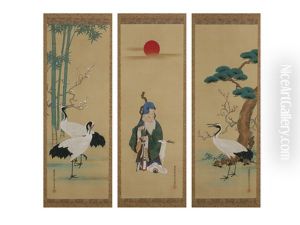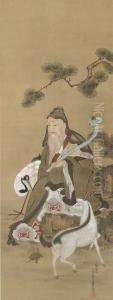Tosa Mitsuyoshi Paintings
Tosa Mitsuyoshi was a prominent Japanese painter of the Azuchi-Momoyama (1568-1600) and early Edo (1603-1868) periods. Born in 1539, he was part of the esteemed Tosa school, which specialized in the yamato-e painting tradition—a style that emphasizes subjects common to Japanese life and narratives, often in a highly decorative manner. The Tosa school had been the dominant school of Japanese painting for centuries and was especially known for its patronage by the imperial family and court.
Mitsuyoshi's father, Tosa Mitsunobu, was also a well-regarded artist, and Mitsuyoshi succeeded him as the head of the Tosa school. During his lifetime, Mitsuyoshi contributed significantly to the development of the Tosa school's distinctive style. His works are characterized by their delicate and detailed brushwork, as well as their use of bright, vibrant colors. Mitsuyoshi's paintings often depicted classical Japanese literature, such as 'The Tale of Genji,' as well as themes from nature and the seasons, which were popular in traditional Japanese art.
In addition to his painting, Mitsuyoshi also played a role in the wider cultural sphere. He was involved in restoring the traditional yamato-e style, which had declined in popularity due to the competing Kano school, which was favored by the ruling samurai class for its bold, Chinese-influenced ink paintings. Despite this competition, Mitsuyoshi managed to secure commissions from the imperial court and various temples and shrines, signifying his and his school's enduring prestige.
Mitsuyoshi's influence extended beyond his lifetime. He trained his son, Tosa Mitsunori, who continued the Tosa school tradition. Mitsuyoshi died in 1613, leaving behind a legacy that would influence Japanese painting for generations. His works are preserved in several museums in Japan, and they continue to be studied as important examples of the yamato-e tradition and the aesthetic values of his time.


